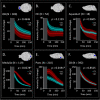Altered dynamics of glymphatic flow in a mature-onset Tet-off APP mouse model of amyloidosis
- PMID: 36707887
- PMCID: PMC9883946
- DOI: 10.1186/s13195-023-01175-z
Altered dynamics of glymphatic flow in a mature-onset Tet-off APP mouse model of amyloidosis
Abstract
Background: Alzheimer's disease (AD) is an incurable neurodegenerative disorder characterised by the progressive buildup of toxic amyloid-beta (Aβ) and tau protein aggregates eventually leading to cognitive decline. Recent lines of evidence suggest that an impairment of the glymphatic system (GS), a brain waste clearance pathway, plays a key role in the pathology of AD. Moreover, a relationship between GS function and neuronal network integrity has been strongly implicated. Here, we sought to assess the efficacy of the GS in a transgenic Tet-Off APP mouse model of amyloidosis, in which the expression of mutant APP was delayed until maturity, mimicking features of late-onset AD-the most common form of dementia in humans.
Methods: To evaluate GS function, we used dynamic contrast-enhanced MRI (DCE-MRI) in 14-month-old Tet-Off APP (AD) mice and aged-matched littermate controls. Brain-wide transport of the Gd-DOTA contrast agent was monitored over time after cisterna magna injection. Region-of-interest analysis and computational modelling were used to assess GS dynamics while characterisation of brain tissue abnormalities at the microscale was performed ex vivo by immunohistochemistry.
Results: We observed reduced rostral glymphatic flow and higher accumulation of the contrast agent in areas proximal to the injection side in the AD group. Clustering and subsequent computational modelling of voxel time courses revealed significantly lower influx time constants in AD relative to the controls. Ex vivo evaluation showed abundant amyloid plaque burden in the AD group coinciding with extensive astrogliosis and microgliosis. The neuroinflammatory responses were also found in plaque-devoid regions, potentially impacting brain-fluid circulation.
Conclusions: In a context resembling late-onset AD in humans, we demonstrate the disruption of glymphatic function and particularly a reduction in brain-fluid influx in the AD group. We conjecture that the hindered circulation of cerebrospinal fluid is potentially caused by wide-spread astrogliosis and amyloid-related obstruction of the normal routes of glymphatic flow resulting in redirection towards caudal regions. In sum, our study highlights the translational potential of alternative approaches, such as targeting brain-fluid circulation as potential therapeutic strategies for AD.
Keywords: Amyloid-beta; Astrogliosis; Brain-fluid circulation; DCE-MRI; Forebrain amyloidosis; Glymphatic system; Inflammation; Mature-onset Tet-off mice.
© 2023. The Author(s).
Conflict of interest statement
The authors declare that they have no competing interests.
Figures






References
-
- Querfurth HW, LaFerla FM. Alzheimer’s disease. N Engl J Med. 2010;362(4):329–344. - PubMed
Publication types
MeSH terms
Substances
LinkOut - more resources
Full Text Sources
Medical
Molecular Biology Databases

